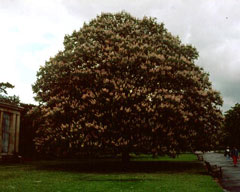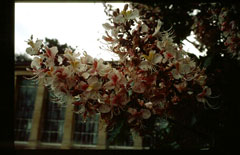 |
|
(c) ken Fern, Plants For A Future 2010 |
 |
| (c) ken Fern, Plants For A Future 2010 |
Translate this page:
Summary
Physical Characteristics

 Aesculus indica is a deciduous Tree growing to 30 m (98ft) by 12 m (39ft).
Aesculus indica is a deciduous Tree growing to 30 m (98ft) by 12 m (39ft).
See above for USDA hardiness. It is hardy to UK zone 7 and is not frost tender. It is in flower from June to July, and the seeds ripen in October. The species is hermaphrodite (has both male and female organs) and is pollinated by Bees.
Suitable for: light (sandy), medium (loamy) and heavy (clay) soils and prefers well-drained soil. Suitable pH: mildly acid, neutral and basic (mildly alkaline) soils. It can grow in semi-shade (light woodland) or no shade. It prefers moist soil.
UK Hardiness Map
US Hardiness Map
Synonyms
Pavia indica.
Plant Habitats
Woodland Garden Canopy;
Edible Uses
Edible Parts: Seed
Edible Uses:
Seed - cooked. It can be dried, ground into a powder and used as a gruel[2, 63, 145, 146, 158]. The seed is roasted then eaten in Nepal[272]. It is also dried then ground into a flour and used with wheat flour to develop the flavour when making bread[272]. The seed is quite large, about 35mm in diameter[194], and is easily harvested. Unfortunately it also contains toxic saponins and these need to be removed before it can be eaten. The seed is used as an emergency food in times of famine when all else fails[177]. It is dried and ground into a powder, this is then soaked in water for about 12 hours before use in order to remove the bitter saponins and can be used to make a 'halva'[194]. It is estimated that mature trees yield about 60kg of seeds per annum in the wild[194]. See also the notes above on toxicity.
References More on Edible Uses
Medicinal Uses
Plants For A Future can not take any responsibility for any adverse effects from the use of plants. Always seek advice from a professional before using a plant medicinally.
Acrid Anthelmintic Antirheumatic Astringent Narcotic Stomachic
The seed is astringent, acrid and narcotic[272]. An oil from the seed is applied externally in the treatment of skin disease and rheumatism[240, 243, 272]. The juice of the bark is also used to treat rheumatism[272]. A paste made from the oil cake is applied to the forehead to relieve headaches[272]. The seed is given to horses suffering from colic[240, 243]. It is also used as an anthelmintic on horses to rid them of intestinal parasites[272].
References More on Medicinal Uses
The Bookshop: Edible Plant Books
Our Latest books on Perennial Plants For Food Forests and Permaculture Gardens in paperback or digital formats.

Edible Tropical Plants
Food Forest Plants for Hotter Conditions: 250+ Plants For Tropical Food Forests & Permaculture Gardens.
More

Edible Temperate Plants
Plants for Your Food Forest: 500 Plants for Temperate Food Forests & Permaculture Gardens.
More

More Books
PFAF have eight books available in paperback and digital formats. Browse the shop for more information.
Shop Now
Other Uses
Soap Wood
Saponins in the seed are used as a soap substitute[169]. The saponins can be easily obtained by chopping the seed into small pieces and infusing them in hot water. This water can then be used for washing the body, clothes etc. Its main drawback is a lingering odour of horse chestnuts[K]. Wood - soft, close grained. Used for construction, cases, spoons, cups etc[145, 146, 158].
Special Uses
References More on Other Uses
Cultivation details
Prefers a deep loamy well-drained soil but is not too fussy[1, 11, 200]. Succeeds on chalk[11]. Dislikes dry soils[11]. This species does very well in south-west England, growing best in areas where the minimum temperatures do not fall below about -5°c[200]. Young shoots in the spring can be cut back by late frosts in low-lying districts[11, 126]. Trees cast quite a dense shade[194]. Most members of this genus transplant easily, even when fairly large[11].
References Carbon Farming Information and Carbon Sequestration Information
Temperature Converter
Type a value in the Celsius field to convert the value to Fahrenheit:
Fahrenheit:
The PFAF Bookshop
Plants For A Future have a number of books available in paperback and digital form. Book titles include Edible Plants, Edible Perennials, Edible Trees,Edible Shrubs, Woodland Gardening, and Temperate Food Forest Plants. Our new book is Food Forest Plants For Hotter Conditions (Tropical and Sub-Tropical).
Shop Now
Plant Propagation
Seed - best sown outdoors or in a cold frame as soon as it is ripe[11, 80]. The seed germinates almost immediately and must be given protection from severe weather[130]. The seed has a very limited viability and must not be allowed to dry out. Stored seed should be soaked for 24 hours prior to sowing and even after this may still not be viable[80, 113]. It is best to sow the seed with its 'scar' downwards[130]. If sowing the seed in a cold frame, pot up the seedlings in early spring and plant them out into their permanent positions in the summer.
Other Names
If available other names are mentioned here
Native Range
TEMPERATE ASIA: Afghanistan (east) TROPICAL ASIA: India (Himachal Pradesh, Jammu and Kashmir, Uttar Pradesh (north)), Nepal, Pakistan (north)
Weed Potential
Right plant wrong place. We are currently updating this section.
Please note that a plant may be invasive in one area but may not in your area so it's worth checking.
Conservation Status
IUCN Red List of Threatened Plants Status :

Growth: S = slow M = medium F = fast. Soil: L = light (sandy) M = medium H = heavy (clay). pH: A = acid N = neutral B = basic (alkaline). Shade: F = full shade S = semi-shade N = no shade. Moisture: D = dry M = Moist We = wet Wa = water.
Now available:
Food Forest Plants for Mediterranean Conditions
350+ Perennial Plants For Mediterranean and Drier Food Forests and Permaculture Gardens.
[Paperback and eBook]
This is the third in Plants For A Future's series of plant guides for food forests tailored to
specific climate zones. Following volumes on temperate and tropical ecosystems, this book focuses
on species suited to Mediterranean conditions—regions with hot, dry summers and cool, wet winters,
often facing the added challenge of climate change.
Read More
Expert comment
Author
(Wall. ex Camb.)Hook.
Botanical References
1151200
Links / References
For a list of references used on this page please go here
Readers comment
© 2010, Plants For A Future. Plants For A Future is a charitable company limited by guarantee, registered in England and Wales. Charity No. 1057719, Company No. 3204567.